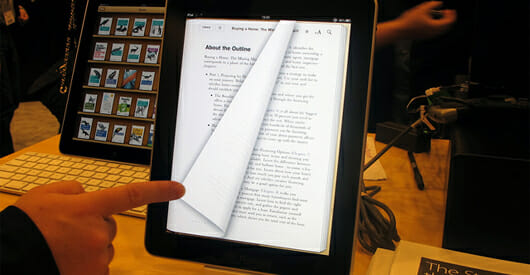
Indie Author April Hamilton responded to my post about typeface combinations for book design with a note about ebooks:
Joel –
Those font combintations look great, but I can only shake my head and sigh knowing none of them would survive the conversion to Kindle (prc), iBook (epub), or most other ebook formats intact—the notable exception being pdf ebooks, but that’s hardly the most popular format. Sadly, font options are still very, very limited where ebooks are concerned.Ebook, thy name is utility.
April, who performs conversions to ebook formats, knows this ground well. For most ebooks, text is one long stream of data, paginated on the fly by the ereading device itself. As soon as your text enters this elastic space, it can be manipulated by users for their own convenience. The font you selected can be replaced, and sizes, line endings, page breaks and other parts of the infrastructure of the book are rendered irrelevant.
Craig Mod, in his great post about ebook reading last year, Books in the Age of the iPad, argued that the Apple iPad was the first reader to be able to display books with the same kind of accuracy in presenting content that printed books do.
He goes on:
The metaphor of flipping pages already feels boring and forced on the iPhone. I suspect it will feel even more so on the iPad. The flow of content no longer has to be chunked into ‘page’ sized bites . . . In printed books, the two-page spread was our canvas. It’s easy to think similarly about the iPad. Let’s not. The canvas of the iPad must be considered in a way that acknowledge the physical boundaries of the device, while also embracing the effective limitlessness of space just beyond those edges.
Trapped in the Past, But At Least There’s Something to Read
Looking at the EPUB versions of lots of books can be dispiriting to a designer. But we are in a primitive and transitional time for books, and we all know it.
Ebooks remind me today of character-mode displays of 20 years ago. We ran programs on what were essentially terminals with green screens and a single set of characters. You had to know how to enter command-line code to get anything done. When I brought home my first PC, I spent an hour typing at the C: prompt and receiving only this in reply:
Unknown command or filename
From there to Mac OS10, the iPhone and the iPad is quite a journey in itself. But ebooks, from what I can see, are still in their infancy.
Partly this is due to the current level of technology, certain to change quickly over the next couple of years. But even more, it’s longstanding habits and cultural memory that will change next.
Then we won’t need sophisticated electronics to spend their energy imitating old books and graceful page turns. Text will leap out of the need for the “page” itself, and connect with all the media converging on these mobile platforms like the iPad.
From the time people started to bind together sheaves of paper, creating the first books, until today, text has been displayed in only a couple of ways. And books, the standard unit of text communication, still use materials and operate by rules laid down in the sixteenth century.
Here are a few things I’m looking for in tomorrow’s ebook experience:
- Text in pages, and not in pages—there are so many ways text can be displayed that might start from the page / spread metaphor, but then go completely beyond it.
- Text in three dimensions—hyperlinks created the first kind of experience of text in dimensions, where depth becomes a factor. Ebooks are perfect vehicles for this type of content-layering.
- Flexibility of the display, not just the content—and by that I mean presenting an eInk-type screen like the Kindle when only text is involved, and a high-resolution color screen like the iPad when other media come into play. Why do we have to choose?
- Dynamic graphics that interact with the text—breaking down the wall between graphics and text is something ebooks can accomplish in totally new ways.
- Context sensitive, location sensitive, environmentally sensitive—harnessing all the computing power in next-generation tablets and other convergent devices can make text responsive to the reader in many new ways.
So my question is, when will ebooks break out of the mold of the printed book? And then what will they look like?
Image licensed under a Creative Commons Attribution 3.0 License, original work copyright by Anita K Hart, https://www.flickr.com/photos/anitakhart/


